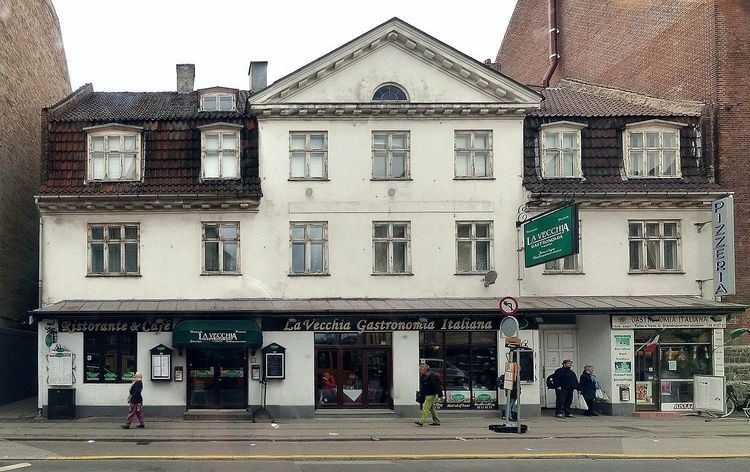 | ||
Falkoner Allé (lit. "Falconer Avenue") is one of the main streets of Frederiksberg in Copenhagen, Denmark. It runs from Frederiksberg Town Hall Square in the south to Ågade on the border with Nørrebro in the north, linking Allégade with Jagtvej. The street takes its name from the Royal Falconry which was located in the area. Remains of the buildings are still found behind the buildings at No. 112–120.
Contents
- Map of Falkoner Alle 2000 Frederiksberg Denmark
- The kings falconry
- Urbanization
- 20th century changes
- Notable buildings and residents
- Sculptury
- References
Map of Falkoner Alle, 2000 Frederiksberg, Denmark
The king's falconry
The street was established in about 1670 as a driveway to Falkonergården, Christian V's new facility for stabling of peregrine falcons for falconry. The falcons, peregrine falcons brought home from Iceland, were used as gifts for foreign rulers by the Danish kings on their journeys abroad. The road was originally gated at each end but it was opened to the public after Hømarken (literally "Hayfield"), an area to the north belonging to Ladegården, a farm under Copenhagen Castle, was auctioned off in lots to wealthy citizens from Copenhagen who built their country houses on the land. The Royal Falconry closed in 1810 and the last falcons were gifted to the Portuguese court. The buildings were then used as a wax candle factory, but were later torn down except for a single wing which is still seen in the alley between No. 112 and No. 120.
Urbanization
The first houses along the tree-lined avenue were built around 1850, but until 1859 Falkoner Allé And Jagtvej marked the so-called Demarcation Line which enforced restrictions on construction of buildings outside Copenhagen's City Walls. Frederiksberg's two first public schools were built in the southern end of the street on the west side. They were joined in 1886 by Frederiksberg's first town hall which later took over the buildings.
The east side of the street was dominated by factories and small workshops: The Ruben Textile Factories opened in 1859 on the corner with Rolighedsvej, employing more than 500 workers by 1890. Frederiksberg Iron Foundry existed from 1872 to the mid-1950s. Further north, also on the east side between Rolighedsvej and Ladegården, was a beer garden and entertainment venue, founded in about 1850, which survived until 1907.
The first apartment buildings in the street were built around 1880. Many of the earliest buildings, typically just two storeys tall, were soon replaced by taller structures. By 1910 the street appeared fully developed.
20th century changes
A fairly large number of the old buildings disappeared in the middle of the 20th century to make way for modern ones. The Ruben Textile Facctory was demolished in 1938, while the old town hall and Frederiksberg Iron Foundry survived until the 1950s.
Notable buildings and residents
Falkoner Center, a hotel and conference venue, has replaced Frederiksberg's old town hall on the corner with Howitzvej. It was completed in 1959 and modernized in 1987. Frederiksberg Gymnasium is located at Falkoner Plads ("Falkoner Square"), an urban space located to the rear of the centre. The Frederiksberg Centre, a shopping mall, is located at No. 21.
Hostrups Have, a Modernist residential complex, enclosing a garden space, is located on the corner with Rolighedsvej.
Sculptury
On Kejserinde Dagmars Plads (literally "Empress Dagmar's Square), the small space opposite Frederiksberg Centre, stands the sculpture Amor and Psyche by Pontus Kjerrmans and in 2013 a Russian society offered to donate a bust of Dagmar for the site.
